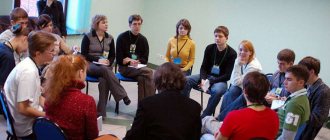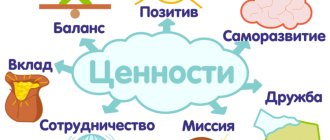Human needs are conditional, mobile, and virtual in nature. The virtuality of needs is that each of them contains its own other, a moment of self-negation. Due to the variety of conditions of implementation, age, environment, biological need becomes material, social or spiritual, i.e. transforms. In the parallelogram of needs (biological need - material - social - spiritual), the dominant need becomes the one that most corresponds to the personal meaning of a person’s life, is better equipped with the means of its satisfaction, i.e. the one who is better motivated.
The transition from need to activity is the process of changing the direction of need from within to the external environment. At the heart of any activity is a motive that encourages a person to do it, but not every activity can satisfy the motive. The mechanism of this transition includes: I) selection and motivation of the subject of need (motivation - justification of the subject to satisfy the need); 2) during the transition from need to activity, the need is transformed into purpose and interest (conscious need).
Thus, need and motivation are closely related: need stimulates a person to activity, and a component of activity is always motive.
Motive of man and personality
A motive is what motivates a person to act, directing him to satisfy a specific need. Motive is a reflection of need, which acts as an objective law, an objective necessity.
For example, the motive can be both hard work with inspiration and enthusiasm, and avoidance as a sign of protest.
Motives can be needs, thoughts, feelings and other mental formations. However, internal motivation is not enough to carry out activities. It is necessary to have an object of activity and correlate the motives with the goals that the individual wants to achieve as a result of the activity. In the motivational-target sphere, the social conditioning of activity appears with particular clarity.
By [[Motivational-need sphere of personality|need-motivational sphere of personality is meant the entire set of motives that are formed and develop during a person’s life. In general, this sphere is dynamic, but some motives are relatively stable and, subordinating other motives, form, as it were, the core of the entire sphere. These motives reveal the direction of the individual.
Motivation of a person and personality
Motivation is a set of internal and external driving forces that motivate a person to act in a specific, goal-directed manner; the process of motivating oneself and others to act to achieve organizational or personal goals.
The concept of “motivation” is broader than the concept of “motive”. Motive, in contrast to motivation, is something that belongs to the subject of behavior, is his stable personal property, which internally encourages him to perform certain actions. The concept of “motivation” has a double meaning: firstly, it is a system of factors influencing human behavior (needs, motives, goals, intentions, etc.), secondly, it is a characteristic of the process that stimulates and supports behavioral activity at a certain level. level.
In the motivational sphere, the following are distinguished:
- motivational system of a person is a general (holistic) organization of all the motivating forces of activity underlying human behavior, which includes such components as needs, actual motives, interests, drives, beliefs, goals, attitudes, stereotypes, norms, values, etc. .;
- achievement motivation - the need to achieve high behavioral results and satisfy all other needs;
- self-actualization motivation is the highest level in the hierarchy of personal motives, consisting of the individual’s need for the fullest realization of his potential, the need for self-realization.
Worthy goals, long-term plans, good organization will be ineffective if the interest of the performers in their implementation is not ensured, i.e. motivation. Motivation can compensate for many deficiencies in other functions, such as deficiencies in planning, but weak motivation is almost impossible to compensate for with anything.
Success in any activity depends not only on abilities and knowledge, but also on motivation (the desire to work and achieve high results). The higher the level of motivation and activity, the more factors (i.e. motives) prompt a person to activity, the more effort he is inclined to put in.
Highly motivated individuals work harder and tend to achieve better results in their activities. Motivation is one of the most important factors (along with abilities, knowledge, skills) that ensures success in activity.
It would be wrong to consider the motivational sphere of an individual only as a reflection of the totality of his own individual needs. The needs of the individual are related to the needs of society and are formed and developed in the context of their development. Some needs of an individual can be considered as individualized social needs. In the motivational sphere of a person, both his individual and social needs are reflected in one way or another. The form of reflection depends on the position the individual occupies in the system of social relations.
Motivation
Motivation is the process of influencing a person in order to encourage him to take certain actions by activating certain motives.
There are two main types of motivation:
- external influence on a person with the aim of inducing him to perform certain actions leading to a desired result. This type resembles a trade deal: “I give you what you want, and you satisfy my desire”;
- the formation of a certain motivational structure of a person as a type of motivation is educational in nature. Its implementation requires great effort, knowledge, and abilities, but the results exceed those of the first type of motivation.
Basic human motives
Emerging needs force a person to actively look for ways to satisfy them and become internal stimulants of activity, or motives. Motive (from Latin movero - to set in motion, to push) is what moves a living being, for which it spends its vital energy. Being an indispensable “fuse” of any actions and their “combustible material”, the motive has always appeared at the level of worldly wisdom in various ideas about feelings (pleasure or displeasure, etc.) - motivations, drives, aspirations, desires, passions, willpower, etc. d.
Motives can be different: interest in the content and process of activity, duty to society, self-affirmation, etc. Thus, a scientist can be motivated to scientific activity by the following motives: self-realization, cognitive interest, self-affirmation, material incentives (monetary reward), social motives (responsibility, desire to benefit society).
If a person strives to perform a certain activity, we can say that he has motivation. For example, if a student is diligent in his studies, he is motivated to study; an athlete who strives to achieve high results has a high level of achievement motivation; The desire of the leader to subordinate everyone indicates the presence of a high level of motivation for power.
Motives are relatively stable manifestations and attributes of personality. For example, when we say that a certain person has a cognitive motive, we mean that in many situations he exhibits cognitive motivation.
The motive cannot be explained on its own. It can be understood in the system of those factors - images, relationships, personal actions that make up the general structure of mental life. Its role is to give behavior impetus and direction towards a goal.
Incentive factors can be divided into two relatively independent classes:
- needs and instincts as sources of activity;
- motives as reasons that determine the direction of behavior or activity.
Need is a necessary condition for any activity, but need itself is not yet capable of giving activity a clear direction. For example, the presence of an aesthetic need in a person creates corresponding selectivity, but this does not yet indicate what exactly the person will do to satisfy this need. Perhaps he will listen to music, or perhaps he will try to compose a poem or paint a picture.
What is the difference between need and motive? When analyzing the question of why an individual generally comes into a state of activity, manifestations of needs are considered as sources of activity. If we study the question of what the activity is aimed at, why these particular actions and actions are chosen, then first of all the manifestations of motives (as motivating factors that determine the direction of activity or behavior) are studied. Thus, need encourages activity, and motive motivates directed activity. We can say that a motive is an incentive to activity associated with satisfying the needs of the subject. The study of motives for educational activities among schoolchildren revealed a system of various motives. Some motives are main, leading, others are secondary, side, they do not have independent meaning and are always subordinate to the leading ones. For one student, the leading motive for learning may be the desire to gain authority in the class, for another it may be the desire to obtain a higher education, for a third it may be an interest in knowledge itself.
How do new needs arise and develop? As a rule, each need is objectified (and specified) in one or several objects that are capable of satisfying this need, for example, an aesthetic need can be objectified in music, and in the process of its development can also be objectified in poetry, i.e. more items can already satisfy her. Consequently, the need develops in the direction of increasing the number of objects that can satisfy it; the change and development of needs occurs through the change and development of objects that meet them and in which they are objectified and concretized.
To motivate a person means to touch on his important interests, to create conditions for him to realize himself in the process of life. To do this, a person must at least: be familiar with success (success is the realization of a goal); to have the opportunity to see yourself in the results of your work, to realize yourself in your work, to feel your importance.
But the meaning of human activity is not only to obtain results. The activity itself can be attractive. A person may enjoy the process of performing an activity, such as being physically and intellectually active. Like physical activity, mental activity in itself brings pleasure to a person and is a specific need. When a subject is motivated by the process of activity itself, and not by its result, this indicates the presence of a procedural component of motivation. In the learning process, the procedural component plays a very important role. The desire to overcome difficulties in educational activities, to test one’s strengths and abilities can become a personally significant motive for studying.
At the same time, an effective motivational attitude plays an organizing role in the determination of activity, especially if its procedural component (i.e., the process of activity) causes negative emotions. In this case, goals and intentions that mobilize a person’s energy come to the fore. Setting goals and intermediate tasks is a significant motivational factor that is worth using.
To understand the essence of the motivational sphere (its composition, structure, which has a multidimensional and multi-level nature, dynamics), it is necessary first of all to consider the connections and relationships of a person with other people, taking into account that this sphere is also formed under the influence of the life of society - its norms, rules, ideology, politicians, etc.
One of the most important factors determining the motivational sphere of an individual is a person’s belonging to any group. For example, teenagers who are interested in sports are different from their peers who are interested in music. Since any person belongs to a number of groups and in the process of his development the number of such groups grows, naturally his motivational sphere also changes. Therefore, the emergence of motives should be considered not as a process arising from the internal sphere of the individual, but as a phenomenon associated with the development of his relationships with other people. In other words, changes in motives are determined not by the laws of spontaneous development of the individual, but by the development of his relationships and connections with people, with society as a whole.
Classification: types and groups, categories
There are a huge number of classifications of motives, and each individual theory offers its own.
Let us consider the most common types of motives in general psychology.
External motives have a much stronger impact on a person, since the conditions are dictated by the environment. Most external motives are primitive and biological in nature: satisfying hunger, thirst, reproduction, dominance.
Internal motives arise in the head of the person himself and have a more complex form. For example, the desire to write a detective novel.
The need itself is of a higher level and has specificity, personified by the individual (one person wants to write a detective novel, a second wants to write a love story, and a third wants to write an indecent word on the fence).
Internal motives are formed from the internal beliefs, attitudes, principles, values and general worldview of the individual. This is a key difference from external motives.
Since the desire to buy an apartment can be both an external (status) and an internal motive (comfort, desire for privacy, a certain degree of freedom). The internal motive is recognized by the person himself, regardless of the opinions of the people around him.
Conscious and unconscious motives . The unconscious (hidden motive) appeals to the limbic system and is not recorded by consciousness. These are instinctual needs.
Guided by the “steal” instinct, a person extracts a resource, and when asked in court why he did it, the person is lost. Or he comes up with a conscious motivation with his brain.
Stable motives. The duration of motivation can be based on both external and internal factors. Long-term negative environmental influences (war, famine, lack of housing) can support active human activity for a long time.
If a person has stable values and beliefs, he can also pursue goals consistent with these beliefs over time.
Functional motives. Process orientation. In this type of motivation, the end result is either unimportant or absent altogether. A person enjoys the activity itself (communication, watching movies, video games).
Personal motives
Personal motives are the need (or system of needs) of the individual for the function of motivation. Internal mental motivations for activity and behavior are determined by the actualization of certain needs of the individual. Activity motives can be very different:
- organic - aimed at satisfying the natural needs of the body and are associated with the growth, self-preservation and development of the body;
- functional - satisfied through various cultural forms of activity, for example playing sports;
- material - encourage a person to engage in activities aimed at creating household items, various things and tools;
- social - give rise to various types of activities aimed at taking a certain place in society, gaining recognition and respect;
- spiritual - they form the basis of those activities that are associated with human self-improvement.
Organic and functional motives together constitute the motivation for the behavior and activity of an individual in certain circumstances and can not only influence, but change each other.
Human needs manifest themselves in specific forms. People may perceive their needs differently. Depending on this, motives are divided into emotional ones - desires, desires, attractions, etc. and rational - aspirations, interests, ideals, beliefs.
There are two groups of interconnected motives of life, behavior and activity of an individual:
- generalized, the content of which expresses the subject of needs and, accordingly, the direction of the individual’s aspirations. The strength of this motive is determined by the significance for a person of the object of his needs;
- instrumental - motives for choosing ways, means, methods of achieving or realizing a goal, conditioned not only by the need state of the individual, but also by his preparedness, the availability of opportunities to successfully act to realize his goals in given conditions.
There are other approaches to classifying motives. For example, according to the degree of social significance, motives of a broad social plan (ideological, ethnic, professional, religious, etc.), group plan and individual-personal nature are distinguished. There are also motives for achieving goals, avoiding failures, motives for approval, and affiliative ones (cooperation, partnership, love).
Motives not only encourage a person to act, but also give his actions and actions a personal, subjective meaning. In practice, it is important to take into account that people, performing actions that are identical in form and objective results, are often guided by different, sometimes opposing motives, and attach different personal meaning to their behavior and actions. In accordance with this, the assessment of actions should be different: both moral and legal.
Types of personality motives
Consciously justified motives include values, beliefs, and intentions.
Value
Value is a concept used in philosophy to indicate the personal, socio-cultural significance of certain objects and phenomena. A person’s values form a system of his value orientations, elements of the personality’s internal structure that are especially significant for him. These value orientations form the basis of the consciousness and activity of the individual. Value is a personally colored attitude towards the world, arising on the basis of not only knowledge and information, but also one’s own life experience. Values give meaning to human life. Faith, will, doubt, and ideal are of enduring importance in the world of human value orientations. Values are part of culture, learned from parents, family, religion, organizations, school, and environment. Cultural values are widely held beliefs that define what is desirable and what is true. Values can be:
- self-oriented, which concern the individual, reflect his goals and general approach to life;
- other-oriented, which reflect the desires of society regarding the relationship between the individual and groups;
- environmentally oriented, which embody society's ideas about the desired relationship of the individual with his economic and natural environment.
Beliefs
Beliefs are the motives of practical and theoretical activity, justified by theoretical knowledge and the entire worldview of a person. For example, a person becomes a teacher not only because he is interested in passing on knowledge to children, not only because he loves working with children, but also because he knows well how much in creating a society depends on cultivating consciousness. This means that he chose his profession not only out of interest and inclination towards it, but also according to his convictions. Deeply held beliefs persist throughout a person's life. Beliefs are the most generalized motives. However, if generalization and stability are characteristic features of personality properties, then beliefs can no longer be called motives in the accepted sense of the word. The more generalized a motive becomes, the closer it is to a personality trait.
Intention
Intention is a consciously made decision to achieve a specific goal with a clear understanding of the means and methods of action. This is where motivation and planning come together. Intention organizes human behavior.
The types of motives considered cover only the main manifestations of the motivational sphere. In reality, there are as many different motives as there are possible person-environment relationships.
If you find an error, please select a piece of text and press Ctrl+Enter.
Theories: briefly
Maslow's motivations
Based on the pyramid of needs he described.
Maslow believed that the simplest needs are primary in the hierarchy ; a person pays great attention to them.
The scientist also focused on the fact that satisfying a higher need is impossible without satisfying the previous one (a person will not be able to engage in self-development if he is hungry or is in an uncomfortable environment).
Expectations
According to this concept, the very fact of the presence of a need is not enough to form a motive . A person expects that the method he has chosen to fulfill a need is effective.
He hopes that a specific method will help him achieve his goal. Motivation theory considers the problem of a person’s choice from many alternative ways to achieve a goal. According to the theory, the more clearly a person sees a future result, the more motivated he is to obtain it.
Justice
According to it, a person compares the effort spent with the final result. And if he spent more resources than he received at the output, then discomfort arises.
Discomfort is transformed into a sense of justice. In simple words, the question arises: “Why did I work so much and get so little?”
Then the person begins to look for a way to restore justice: either deliberately make less effort (since the work will not be appreciated anyway), or demands “extra pay” for the effort (increase in salary, promotion, bonus or other status attributes).
This theory of motives is used in management and considers, first of all, the motivation of employees.











